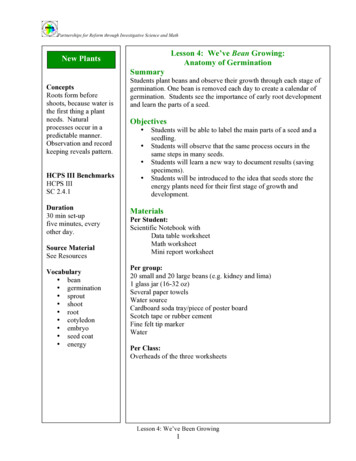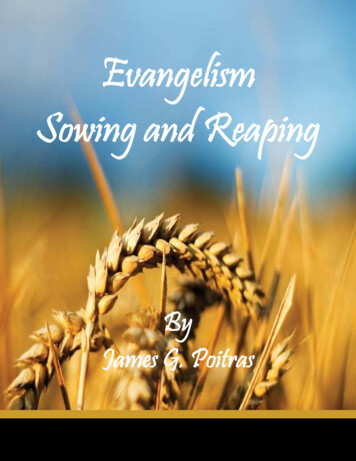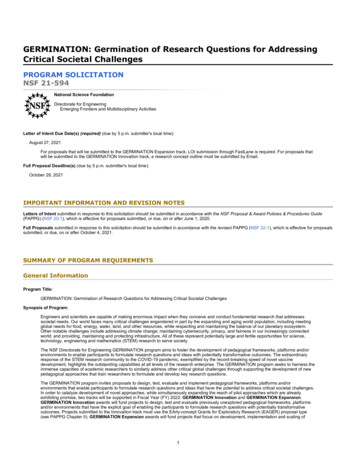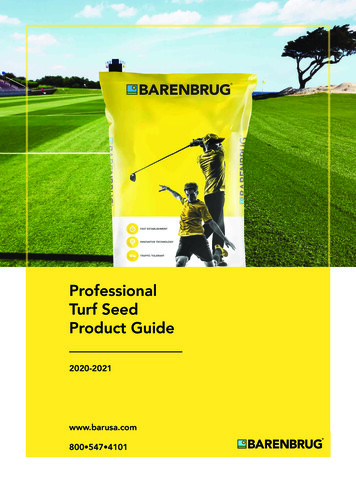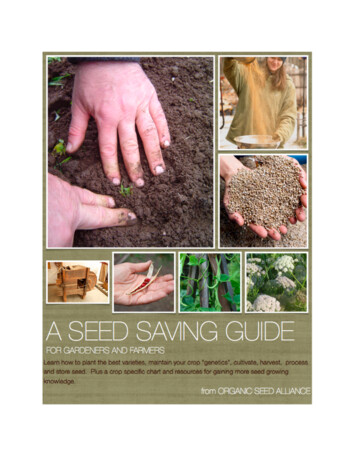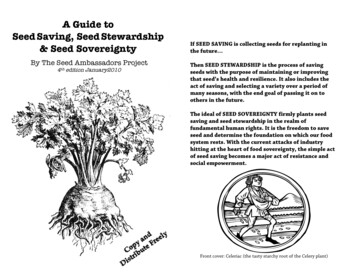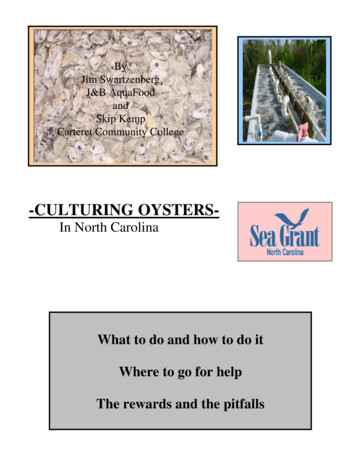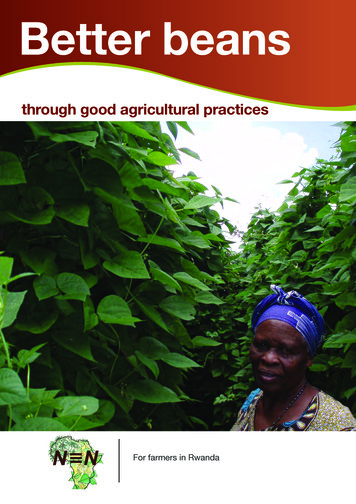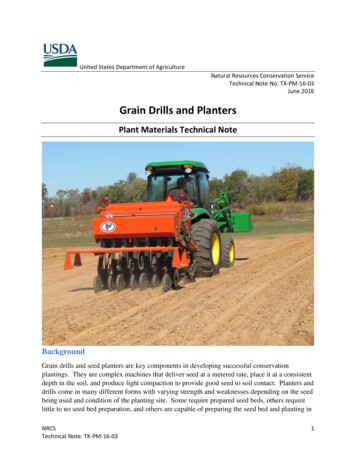![Seed Germination And Sowing Options [Chapter 9] - US Forest Service](/img/30/wo-ah732-163-183.jpg)
Transcription
Seed Germination andSowing OptionsTara Luna, Kim M. Wilkinson, and R. Kasten Dumroese9Seeds of many native species are challenging to germinate. One important thing agrower can do is to learn as much as possible about the life history, ecology, and habitat of the species he or she wishes to grow to understand the processes seeds from eachtarget species go through in nature. Any observations will be valuable when tryingto germinate and grow species that have little or no published information available.How seeds are handled, treated, and sown can affect the genetic diversity and the quality of the crop produced. Growers need to balance the desire for uniform crops andschedules with the need to protect the diverse characteristics within species. In thischapter, we discuss seed characteristics, treatments to improve or stimulate germination, and different types of sowing options for seeds.Facing Page: Hand-sowing. Photo by Tara Luna.163
Seed CharacteristicsAs discussed in Chapter 8, Collecting, Processing, andStoring Seeds (and shown in figure 8.8), tropical seeds can bedivided into four categories related to their longevity and ability to be stored (Hong and Ellis 2002, Kettle and others 2011).Viviparous: seeds that germinate before they are dispersed from the mother plant. The most common examplesare some species of mangroves such as Avicennia andRhizophora and some tropical legumes.Recalcitrant: seeds that germinate soon after maturation and dispersal from the mother plant, and cannot bedried without losing viability. Most species from the wet,humid tropics have recalcitrant seeds because conditionsin these environments are consistently favorable for germination and seedling establishment. Examples of commonspecies with recalcitrant seeds include cacao, mango, longon, and jackfruit.Intermediate: seeds that can germinate immediatelybut may also survive partial drying without losing viability.For example, papaya seeds that have been dried to 10-percent moisture content have been stored successfully underconditions of 50-percent relative humidity for 6 yearswithout affecting viability (Vozzo 2002). Species that haveshown intermediate storage behavior include neem, cinnamon, citrus, mahogany, and coffee.Orthodox: seeds that can be dried without losing viability. These seeds are considered “dormant” and oftenrequire specific treatments to encourage germination. Dormant seeds will not germinate immediately upon maturation and dispersal from the mother plant even when idealenvironmental conditions exist.Tropical species inhabiting areas with a strong wet-dryseasonal cycle, arid or semiarid climates, or at high elevations subjected to cold temperatures often have dormantseeds. The degree of dormancy in these species can varyamong and within seed lots, between seed crop years,and individuals. Examples of species with dormant seedsinclude acacias such as Hawai‘i’s native Acacia koa, andpines including the Caribbean’s Pinus caribaea.Dormancy may be caused by factors outside (external)or inside (internal) to the seeds. Some species have a combination of external and internal dormancy, a conditionknown as double dormancy. Knowing the type of seed dormancy is essential for successful propagation.External Seed DormancyExternal seed dormancy may be physical, physicalphysiological, chemical, or mechanical (Baskin and Baskin1998, 2004). Seeds that have hard, thick seedcoats that physically prevent water or oxygen movement into seeds havephysical dormancy. Physical dormancy is the most commonseed dormancy type seen in the tropics. Species with externaldormancy include many of the legumes (Fabaceae), mallows(Malvaceae), and other tropical species that are adaptedto fire, or inhabit arid to semiarid island habitats or areaswith pronounced wet-dry seasonal cycles. These seeds normally germinate over a period of several years. Dependingon species and habitat, various environmental factors causethese seeds to become permeable over time or during a certain time of year. Seeds that require additional exposure toparticular temperatures after they become permeable havephysical-physiological dormancy.Before attempting to grow a plant, it is important toknow the seed germination type because that helps determine the best seed treatments and sowing options for thatseed. For orthodox seeds, knowing about the species helpsyou to provide the best conditions to dissipate, or “break,”seed dormancy and achieve good rates of germination.The fruits that enclose the seeds cause other forms ofexternal dormancy. Chemical dormancy describes fruitsthat contain high concentrations of germination inhibitorsthat prevent spontaneous germination of seeds. Mechanicaldormancy describes tough, woody fruit walls that restrictseed germination and is best exemplified by the husks thatsurround coconuts (Cocos nucifera).Dormancy in Orthodox SeedsInternal Seed DormancyDormancy is an adaptation that ensures seeds will germinate only when environmental conditions are favorable for survival. The conditions necessary to allow seedsto break dormancy and germinate can be highly variableamong species, within a species, or among seed sourcesof the same species. This degree of variability is advantageous because seeds will germinate at different times over aperiod of days, weeks, months, or even years, ensuring thatsome offspring will be exposed to favorable environmentalconditions for survival.Internal dormancy may be morphological, physiological,or both (Baskin and Baskin 1998). Seeds with morphologicaldormancy have an underdeveloped embryo when dispersedfrom the mother plant. A period of after-ripening (usuallywarm and moist conditions) is needed for the embryo to fullymature before the seed is capable of germination. Tropicalspecies that exhibit morphological dormancy are found in theAnnonaceae, Dilleniaceae, Magnoliaceae, and Myristicaceaefamilies and in many palm species. Seeds of this type may notgerminate for several months to 1 year after sowing.164Tropical Nursery Manual
Physiological dormancy is found in some speciesin arid and semi-arid tropical environments. Seeds arepermeable to water, but certain environmental conditions are necessary to modify the internal chemistry ofthe seed and thus enable germination. Usually a periodof cold, moist conditions or holding seeds in dry storageovercomes physiological dormancy.Seeds with morphological-physiological dormancyusually require a combination of warm and cold conditions, often over an extended period of time, before theyare capable of germination.Treatments To OvercomeSeed Dormancy and EnhanceGerminationA variety of seed treatments have been developed inresponse to the diversity of seed types grown in nurseries.Before treating seeds, be sure to consult available referencesto see what treatments have been used on that species; seethe literature cited at the end of this chapter and the NativePlant Network (http://www.native plantnetwork.org). If noinformation is available, check references for closely relatedspecies. Any personal observations made on the species in thehabitat may also provide some clues on how to germinate theseeds. In general, however, the process of treating seeds follows a fairly standard progression outlined in the followingFigure 9.2—Seeds that are not cleaned before treatment orsowing can easily mold or be susceptible to serious pathogenssuch as damping-off disease. Photo by Thomas D. Landis.sections. Nondormant seeds are planted immediately aftercollection and cleaning. Intermediate seeds may be storedfor several weeks or months in suitable conditions, and thencleaned, fully rehydrated, and sown. For dormant (orthodox) seeds, dormancy must be overcome using one or moreof the methods described in this chapter before seeds can berehydrated, enabling germination. It is essential to determinewhich type(s) of dormancy the seed has so you can do whatis needed to overcome dormancy (figure 9.1). The nurserymust determine whether seeds will need to be cleaned, scarified, soaked, stimulated, stratified, and treated in other waysbefore sowing on a species-by-species basis. The followingsections describe the seed treatment options available.CleaningSeed cleaning helps prevent diseases in the nursery. Cleaning seeds of bacterial and fungal infestation is especially necessary for species that easily mold (figure 9.2). Often, moldingcan be related to the most common disease seen in nurseries,damping-off. Seed cleaning is especially important in humidclimates and for species that take a long time to germinate.Often, without cleaning, seeds can be lost to pathogens beforethey are planted in the nursery.One of the best cleaning methods is to simply soak seedsin a stream of running water for 24 to 48 hours. The running water flushes bacterial and fungal spores from the seeds(James and Genz 1981). This treatment can also be used tosatisfy the soaking requirement described in the next section.Figure 9.1—Key to dormancy types. Knowing the type of seeddormancy is essential to successful seed propagation. Illustrationby Jim Marin.Seed Germination and Sowing OptionsSeeds can also be cleaned with several chemicals, someof which also act to stimulate germination. Bleach (5.25percent sodium hypochlorite) is the most common chemical used. Depending on the species, bleach cleaning solutions range between one part bleach in eight parts water totwo parts bleach in three parts water. With most species,165
treatment duration is 10 minutes or less. Species with verythin seed coats should not be cleaned with bleach. Hydrogen peroxide can be an effective cleanser and can sometimes enhance germination (Narimanov 2000). The usualtreatment is one part peroxide in three parts water. Tropicalspecies that benefit from hydrogen peroxide rinses includeAlbizia species and camphor tree seeds (Vozzo 2003).ScarificationSeeds with external dormancy require scarification.Scarification is any method of disrupting an impermeableseed coat so that water and oxygen can enter the seeds.In nature, hard seed coats are cracked or softened by fire,extreme temperatures, digestive acids in the stomachs ofanimals, or by the abrasion of blowing sand. After the seedcoat has been disrupted, oxygen and water pass into theseeds and germination can proceed.Seeds can be scarified many ways. How well the methodworks depends on the species and the thickness of the seedcoats. Whichever method is chosen, it is very important notto damage the endosperm, cotyledons, or embryo duringthe treatment. Taking time to learn seed anatomy of theABFigure 9.4—Hobby-size rock tumblers can be used to scarify seedsand avoid seed destruction that can occur with sulfuric acid or heatscarification. Photo by Tara Luna.species is helpful. Trying several methods and recordingthe results will help determine the best method for that species and seed source.Mechanical ScarificationMechanical scarification includes filing or nicking seedsby hand and is most often used on large-seeded species suchas Acacia, Cassia, and Sesbania (figure 9.3). Be sure to scarify on the side of the seed opposite the embryo. It is oftendone one seed at a time with a nail clipper. This method istime consuming and requires precision to adequately scarifythe seed coat without damaging the internal portions of theseed. Sandpaper can be used on smaller seeded species suchas sedges; placing seeds into a shallow wooden box and thenrubbing them under a block of wood covered in sandpaper isthe simplest technique. Often, however, the degree of scarification achieved with sandpaper can be variable.Hobby-size rock tumblers can be used to process largebatches of seed more quickly than manual mechanicalscarification (figure 9.4). Dry tumbling involves placingseeds, a coarse carborundum grit (sold by rock tumblerdealers), and pea gravel in the tumbler and tumbling forseveral hours or several days. Wet tumbling includes theaddition of water to the grit and pea gravel. A benefit of wettumbling is that seeds are soaked in well-aerated water andchemical inhibitors may be leached from the seed.Heat ScarificationFigure 9.3—Mechanical scarification works well with large,easy-to-handle seeds. Great care is needed, however, so that theembryo or cotyledons are not damaged. Koa seed hand scarification (A), scarified lotus seeds (B). Photo A by Craig R. Elevitch,and photo B by Cardno JFNew Native Plant Nursery.166Many species, especially those from fire-adapted ecosystems, respond to germination cues from heat. Usingeither wet or dry heat to scarify the seeds can simulate thisresponse. Using wet heat is an effective method for manysmall-seeded species because it provides a rapid, uniformtreatment that can be assessed within a few hours. WetTropical Nursery Manual
duration is known, the entire seedlot can be treated. Sulfuricacid is very dangerous to handle and requires special equipment, personal protective gear, and proper disposal after use.It should never be poured down sink drains. If acid is beingdiluted in water, the acid must be added to the water, neveradd water to acid—when water is added to acid, heat willbe released, risking an explosion and other dangers. Somespecies have thick seed coats but can easily be damaged bysulfuric acid. Instead, citric acid or sodium or calcium hypochlorite baths with longer treatment durations may be used.The safe use of sulfuric acid requires the following procedures:Figure 9.5—Seeds that have been scarified by hot water arevisibly larger than untreated seeds because the seed coat has beenbreached and seeds can then absorb water increasing their size.Photo by Greg Morgenson. Treat seeds that are dry and at room temperature.heat treatments are effective for many tropical speciesincluding Acacia, Cassia, Senna, Sesbania, and Tamarindus (Vozzo 2002). Because the thickness of the seedcoat may vary among sources, it is wise to dissect a fewseeds and examine the thickness of their seed coats tohelp determine treatment duration. Seeds are added toboiling water for 5 to 10 seconds and then immediatelytransferred to a vat of cold water so that they cool quicklyto prevent embryo damage. Seeds imbibe the cool waterfor 1 day and are then ready for sowing or for stratification (figure 9.5). Some species cannot tolerate excessivelyhigh temperatures, so you may want to heat the water toonly 158 F (70 C) and monitor your results. If diluting, add acid to water, never water to acid.Dry heat is most commonly used on fire-adapted species. Seeds are placed in an oven at temperatures rangingfrom 175 to 250 F (80 to 120 C) from a few minutes to1 hour, depending on the species. The seed coat cracksopen in response to the heat. To avoid damaging seeds, thistreatment needs to be monitored closely. Require workers to wear safety equipment, including face shield, goggles, thick rubber gloves, and fullprotective clothing. Immerse seeds in an acid-resistant container, such asa glass, for the duration required. Stir seeds carefully in the acid bath; a glass rodworks well. Immerse the container with seeds and acid in anice bath to keep temperatures at a safe level for theembryos (this temperature depends on the species;many do not need this step). Remove seeds from the acid by slowly pouring theseed-acid solution into a larger volume of cool water,ideally one in which new, fresh water is continuallybeing added. Stir seeds during water rinsing to ensure all surfacesare thoroughly rinsed clean.Chemical ScarificationSulfuric acid is most commonly used on species with verythick seedcoats and with stony endocarps that surround theembryo (figure 9.6). It has been used on some species of Acacia, Albizia, Cassia, Leucaena, Parkinsonia, and Terminalia(Vozzo 2002). Treatment length varies with the species andoften among seed sources, and it must be carefully monitoredbecause seeds can be destroyed if the treatment is too long.A simple way to monitor the process is by removing seeds atregular intervals and cutting them with a sharp knife. Whenthe seeds are still firm but can be cut fairly easily, the treatment is probably sufficient. Another way is to run a pilot teston a subsample of seeds. Again, remove some seeds periodically and evaluate how well they germinate. After the bestSeed Germination and Sowing OptionsFigure 9.6—Seeds that have been treated with sulfuric acid. Photoby Nancy Shaw.167
species having underdeveloped embryos. In some cases,it has been used to substitute for a warm, moist treatment and to hasten embryo after-ripening. Sandalwoodis a species that has been successfully germinated usinggibberellic acid. Gibberellic acid can be purchased fromhorticultural suppliers. Preferred concentrations vary,but most nurseries use 500 to 1,000 parts per million(ppm). High concentrations can cause seeds to germinate, but the resulting seedlings may be of poor quality.Therefore, it is best to experiment with low concentrations first. The following are some guidelines for treatingseeds with gibberellic acid:Figure 9.7—Many species of dormant seeds benefit from 1 to several days of water soaking before sowing to fully imbibe seeds andremove any chemical inhibitors within the seeds or on the seed coats.Photo by Brian F. Daley.Soaking Gibberellic acid takes a long time to dissolve. It mayneed constant stirring or you may want to prepare itthe day before use. Store unused solution away from direct sunlight. Cut unbleached coffee filters into squares and foldthem diagonally. Place gibberellic acid solution evenly into an ice cubetray.After cleaning and scarification, seeds must have exposure to water and oxygen before germination can occur. Thestandard procedure is to soak seeds in water for 1 to severaldays until they are fully hydrated (figure 9.7). Hydrationcan be checked by taking a sample, allowing it to dry untilthe seed coat is still wet but dull, not glossy, and weighingit. When the weight no longer increases substantially withadditional soaking time, the seeds have absorbed sufficientwater. Scarified seeds will be more obvious; the seeds willenlarge drastically during the soak. Seeds that only had physical dormancy can be immediately planted. As mentionedpreviously, running water rinses are effective seed cleaningtreatments that reduce the need for fungicides in nurseries(Dumroese and others 1990). Running water soaks also helpto remove any chemical inhibitors present on or within theseeds. An aquarium pump can be used to agitate the seeds toimprove the cleaning effect and keep the water well aerated.If seeds are not soaked with running water, change the wateroften (at least a couple of times each day).This gas occurs naturally in plants and is known to stimulate the germination of some species. Ethylene gas is releasedfrom ethephon, a commercially available product. Ethephon,used either alone or in combination with gibberellic acid, hasenhanced the germination in doum palm (Mousa and others1998) and may be used for other species inhabiting arid tosemi-arid tropical and saline environments. It may inhibitgermination in other species, so consult the literature andexperiment before using operationally.Germination StimulatorsSmoke TreatmentsSeveral chemicals are known to increase seed germination. These chemicals are usually applied after seeds arefully hydrated. In general, only seeds with internal dormancyreceive this treatment. Germination stimulators include gibberellic acid, ethylene, smoke, and potassium hydroxide.Gibberellic AcidGibberellic acid is the most important plant hormone forthe regulation of internal seed dormancy and is often usedon seeds with complex internal dormancy and with those168 Place each folded coffee filter containing the seedsinto the wells of the tray so that it wicks up the solution. After 24 hours, remove and either sow directly orplace seeds into fresh coffee filters moistened withdistilled water for stratification.EthyleneSmoke stimulates germination in many fire-adaptedspecies; for example, species from the California chaparral,longleaf pine communities in Florida, or species from firedependent ecosystems in Australia, South Africa, parts ofSouth America, and the Mediterranean. Smoke especiallystimulates seeds that have thin, permeable seed coats thatallow entry of smoke into the seeds (Keeley and Fotheringham 1998). Seeds can be treated with smoke fumigation, amethod in which smoke is piped into a specially constructedsmoke tent containing seeds sown in trays (figure 9.8A),Tropical Nursery Manual
Awas very important in some species; a 3-minute differencein exposure resulted in seed mortality. Some fire speciesdid not germinate under heat or smoke treatments alone.With some species, seed burial for 1 year or stratificationwas required in addition to smoke exposure. All thesefactors can have an effect on germination and should beconsidered when determining whether to use smoke treatments. Success with this novel treatment will require trials,so good record keeping is critical.Potassium Hydroxide RinsesBPotassium hydroxide has been used to stimulate germination in several native plant species. Optimum concentration varies from 5.3 to 7.6 Molar for 1 to 10 minutesdepending on the species; longer soaks at higher concentrations were found to be detrimental (Gao and others 1998).Other StimulantsPotassium nitrate, thiourea, and kinetin have been usedto stimulate germination in seeds, although the use of thesecompounds with tropical native plants is lacking. You maychoose to experiment with these compounds on a limitedbasis with difficult-to-germinate seeds.Temperature and Moisture TreatmentsFigure 9.8—Smoke treatments have been used to overcome seeddormancy and enhance germination rates for many native speciesinhabiting fire-dependent ecosystems. A smoke tent for treatingseeds (A). Smoke water-treated seeds of angelica (B). Photo A byKingsley Dixon, and photo B by Tara Luna.or with smoke water. Smoke water is an aqueous solutionof smoke extract made by burning vegetation and pipingthe smoke through distilled water or allowing the smoketo infuse into a container of water. Seeds are then soakedin the treated water (figure 9.8B). Conversely, growers canexperiment with commercially available smoke productssuch as liquid smoke or smoke-infused paper discs, or byadding ash to growing media.Many variables, such as the material used for combustion, the combustion temperature, and the duration ofexposure, will need to be determined on a species-by-species basis. Experiments performed by Keeley and Fotheringham (1998) found that the length of exposure to smokeSeed Germination and Sowing OptionsMany seeds with internal dormancy require a moistperiod at certain temperatures similar to what occurs inthe natural habitat before they germinate and grow. Historically, stratification was a temperate zone practice ofalternating layers of moist soil and seeds in barrels andallowing these “strata” to be exposed to winter temperatures. Nowadays, stratification is often used more generically to describe the combined use of moisture and anytemperature to overcome seed dormancy. We use the term“stratification” to refer to only cold, moist treatments (rareto use in the tropics, but we cover it anyway for nurseriesgrowing highland species). We use the term “warm, moisttreatment” instead of “warm, moist stratification.”Some native species with double internal seed dormancyrequire a combination of a warm, moist treatment for aperiod of time followed by stratification. Some species orseedlots may require only a few days or weeks of stratification, while others may require several months. As a generalrule, it is best to use the maximum recommended treatment.Also keep in mind that what works well at one nursery maynot necessarily work well at another nursery because of differences in seed source, handling, processing, cleaning, andstorage. An advantage to stratifying seeds of some species isthat it can speed up germination and make it more uniform,which is desirable in a container nursery.169
Warm, Moist TreatmentsWarm, moist treatment enhances after-ripening ofseeds with underdeveloped embryos. Warm, moist treatedseeds are kept at temperatures of 72 to 86 F (22 to 30 C)for a period of time, usually in moist peat moss, sawdust, orother substrate. Although warm, moist treatments are notcommonly used on tropical species, it can be considered forseeds with morphological or physiological seed dormancy.StratificationStratification (cold, moist treatment) is used on seeds withinternal dormancy from temperate areas, or high-elevationhabitats in tropical regions. Some subtropical species may alsobenefit from a period of cool, moist stratification. In climateswith four seasons, seeds sown in flats or containers in latesummer or autumn and left outdoors during winter undergo“natural” stratification. This technique may be preferred if thespecies has double dormancy (requires both a warm, moisttreatment or stratification), requires a very long stratificationor requires low temperatures or fluctuating temperatures fora long period of time. Conversely, “artificial” stratificationinvolves placing seeds under refrigeration at 34 to 38 F (1 to3 C) for a period of time. Artificial stratification has severaladvantages: (1) it allows for a routine check of seeds to ensurethey are moist and not moldy, (2) a large number of seeds canbe stratified in a small space, and (3) seeds or seedlots thatbegin to germinate can be removed from the treatment andplanted in the nursery as they become available. ArtificialAstratification is preferred over natural stratification unless thenatural treatment provides higher rates of germination.For artificial stratification of small seedlots and smallseeds, seeds can be placed between sheets of moistenedpaper towels and inserted in an opened plastic bag or sownon a medium in flats with drainage holes. Paper towelsneed to be moist but not waterlogged, and seeds need to beevenly spread across the moist paper towel to help preventmolding (figure 9.9).Another technique is “naked” stratification. Most coniferseeds, for example, are stratified in this manner (figure 9.10).Seeds are placed in mesh bags and then soaked in runningwater as described previously. After the seeds are hydrated,the bag is pulled from the soak, allowed to drip dry for 30 to90 seconds, and then suspended in a plastic bag. Make surethe seeds are not in contact with standing water in the bagand hang the bags in the refrigerator. If naked seeds need awarm, moist treatment before stratification, it is easiest tofirst spread the seeds onto moistened paper towels enclosedin large plastic bags. After the warm treatment, the seeds canbe returned to the mesh bags for stratification. One otherhint: if a particular species or seedlot has a tendency to begingerminating during stratification, surface-dry the seed coats(seeds should be moist and dull, not shiny), and then put theseeds into the bag for refrigeration. The seeds need to stillhave enough moisture for chemical processes that dissipate dormancy to occur but not enough moisture to allowfor germination.BFigure 9.9—Small seeds requiring only a few weeks of stratification can be stratified by moistening paper towels and holding by corner tolet excess water drain away (A) or placing seeds onto moistened towels inserted into an unopened plastic zippered bag (B). Illustrations fromDumroese and others (1998).170Tropical Nursery Manual
ABFigure 9.10—Naked stratification: After soaking seeds in a mesh bag, allow the bag to drip dry for 1 minute and then suspend the meshbag in a plastic bag (A). Hang the bag in the refrigerator. Make sure the seeds are not in constant contact with standing water in the plasticbag (B). Illustrations from Dumroese and others (1998).Many wetland and aquatic species can be treated withnaked stratification in water. In general, these species canbe easily stratified in Ziploc -type bags filled with water.Insert a soda straw into the bag, ensuring that the end issticking out of the bag, to allow some oxygen to reach theseeds. Then, seal the rest of the bag securely. Place underrefrigeration if in need of a cold, moist stratification period.Environmental FactorsInfluencing GerminationFour environmental factors affect germination: light,water, oxygen, and temperature. All plants have specificgermination requirements based on ecological adaptationsand the environmental cues that trigger germination forthat species.need to be sown on the surface of the medium so they areexposed to light during germination. Other species areconditioned to germinate only if they are buried in thesoil. Species requiring darkness to germinate are thosethat germinate readily under the deep shade of a closedforest canopy. Tropical trees and shrubs with medium tolarger sized seeds often require darkness for maximumgermination, but shade tolerant vines and herbaceousplants may have smaller seeds. Other species requiringdarkness to germinate include some of the species thatcolonize sand dunes along coastlines.LightLight quality and duration can influence germination.In nature, seeds of tropical pioneer species require highlight levels associated with a canopy gap for germination and establishment, whereas shade tolerant speciesgenerally can germinate in very poor light or deep shade.Many small-seeded, tropical native species fall into thiscategory. Thus, pioneer species, such as ‘ōhi‘a in Hawai‘i,with very small dust-like seeds (figure 9.11), require lightfor germination and fail to germinate even if they are buried only 2 mm deep (Drake 1993). Therefore, these seedsSeed Germination and Sowing OptionsFigure 9.11—In general, small-seeded pioneer species such as‘ōhi‘a require light to germinate and must not be buried. Photoby Tara Luna.171
Water and Oxygenseeds. Many tropical tree species germinate to their highest percentages at alternating temperatures of 86/68 F(30/20 C
Seed Characteristics. As discussed in Chapter 8, Collecting, Processing, and Storing Seeds (and shown in figure 8.8), tropical seeds can be . divided into four categories related to their longevity and abil -
